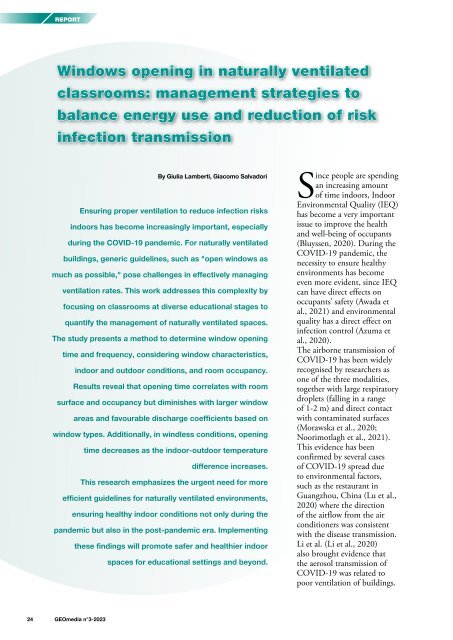GEOmedia_3_2023
EUMAP During the recent pandemic period, the world's attention has shifted towards the healthcare sector, with world leaders striving to avoid the collapse of their national healthcare systems; the economy has entered an artificial coma, while utility systems, including energy, water, telecommunications and waste management systems, have been asked to act immediately in response to these unprecedented conditions, placing extreme pressure on public utility systems.
EUMAP
During the recent pandemic period, the world's attention has shifted towards the healthcare sector, with world leaders striving to avoid the collapse of their national healthcare systems; the economy has entered an artificial coma, while utility systems, including energy, water, telecommunications and waste management systems, have been asked to act immediately in response to these unprecedented conditions, placing extreme pressure on public utility systems.
Create successful ePaper yourself
Turn your PDF publications into a flip-book with our unique Google optimized e-Paper software.
REPORT<br />
Windows opening in naturally ventilated<br />
classrooms: management strategies to<br />
balance energy use and reduction of risk<br />
infection transmission<br />
By Giulia Lamberti, Giacomo Salvadori<br />
Ensuring proper ventilation to reduce infection risks<br />
indoors has become increasingly important, especially<br />
during the COVID-19 pandemic. For naturally ventilated<br />
buildings, generic guidelines, such as "open windows as<br />
much as possible," pose challenges in effectively managing<br />
ventilation rates. This work addresses this complexity by<br />
focusing on classrooms at diverse educational stages to<br />
quantify the management of naturally ventilated spaces.<br />
The study presents a method to determine window opening<br />
time and frequency, considering window characteristics,<br />
indoor and outdoor conditions, and room occupancy.<br />
Results reveal that opening time correlates with room<br />
surface and occupancy but diminishes with larger window<br />
areas and favourable discharge coefficients based on<br />
window types. Additionally, in windless conditions, opening<br />
time decreases as the indoor-outdoor temperature<br />
difference increases.<br />
This research emphasizes the urgent need for more<br />
efficient guidelines for naturally ventilated environments,<br />
ensuring healthy indoor conditions not only during the<br />
pandemic but also in the post-pandemic era. Implementing<br />
these findings will promote safer and healthier indoor<br />
spaces for educational settings and beyond.<br />
Since people are spending<br />
an increasing amount<br />
of time indoors, Indoor<br />
Environmental Quality (IEQ)<br />
has become a very important<br />
issue to improve the health<br />
and well-being of occupants<br />
(Bluyssen, 2020). During the<br />
COVID-19 pandemic, the<br />
necessity to ensure healthy<br />
environments has become<br />
even more evident, since IEQ<br />
can have direct effects on<br />
occupants’ safety (Awada et<br />
al., 2021) and environmental<br />
quality has a direct effect on<br />
infection control (Azuma et<br />
al., 2020).<br />
The airborne transmission of<br />
COVID-19 has been widely<br />
recognised by researchers as<br />
one of the three modalities,<br />
together with large respiratory<br />
droplets (falling in a range<br />
of 1-2 m) and direct contact<br />
with contaminated surfaces<br />
(Morawska et al., 2020;<br />
Noorimotlagh et al., 2021).<br />
This evidence has been<br />
confirmed by several cases<br />
of COVID-19 spread due<br />
to environmental factors,<br />
such as the restaurant in<br />
Guangzhou, China (Lu et al.,<br />
2020) where the direction<br />
of the airflow from the air<br />
conditioners was consistent<br />
with the disease transmission.<br />
Li et al. (Li et al., 2020)<br />
also brought evidence that<br />
the aerosol transmission of<br />
COVID-19 was related to<br />
poor ventilation of buildings.<br />
24 <strong>GEOmedia</strong> n°3-<strong>2023</strong>

















